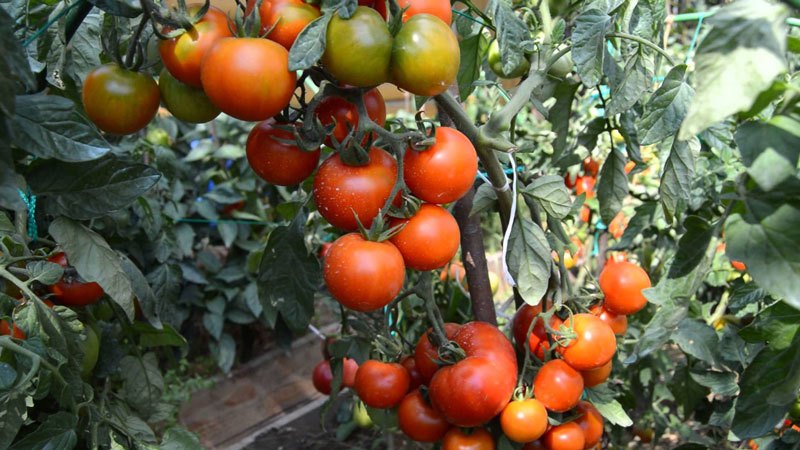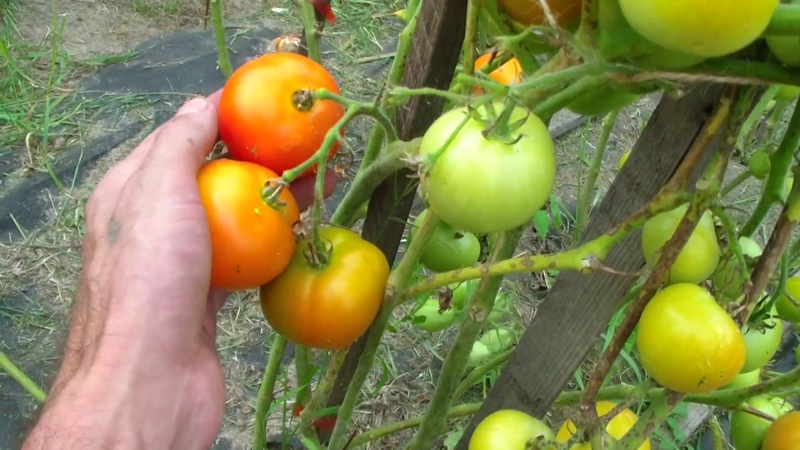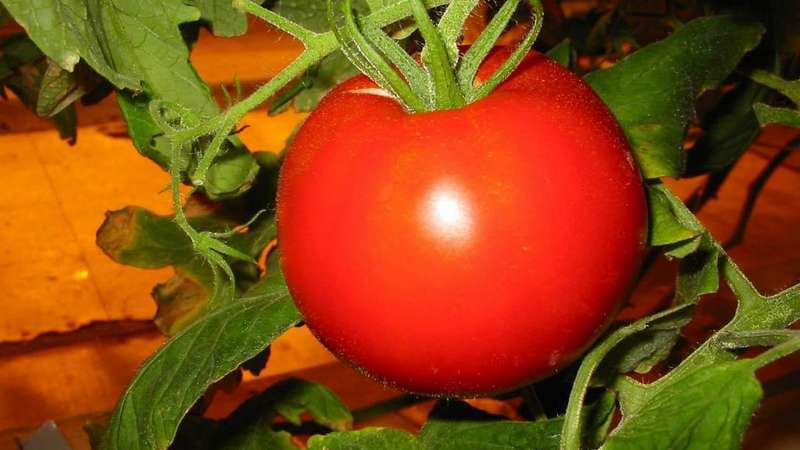Ultra-early tomato "White filling": we grow seedlings from seeds, transplant them into a greenhouse or soil and enjoy the harvest
The variety White filling 241 is loved by Russian gardeners for its unpretentiousness and early appearance of fruits. These tomatoes cannot be called ideal, since the variety has a significant drawback - the plant is susceptible to late blight. In this article, we'll show you how to grow a good crop of tomatoes and defeat their main enemy.
The content of the article
Description of the variety
Russians have known White filling 241 for more than 50 years - Kazakhstani breeders registered the variety in the Unified State Register in 1966. Today, seeds are sold from two producers: the Aelita agricultural firm and the Timofeev breeding station.
Many people mistakenly believe that White filling and White filling 241 are different subspecies of the same tomato variety, but this is not the case.
In the description of the goods, the manufacturer indicates that the variety is early ripening, fruitful. Susceptible to fungal diseases. Recommended for open ground.
Distinctive features
Tomatoes are thermophilic plants. Therefore, selected for regions with cold summers (the North, North-West and Western Siberia, as well as the Central, Central Black Earth, Volgo-Vyatka and Middle Volga regions) White filling has become a real boon for summer residents. It is unpretentious to care for, it is considered the easiest to grow.
Variety determinant... The height of the bush is from 50 cm (outdoors) to 70 cm (in a greenhouse). Sturdy, strong stem. The roots of the plant grow up to 50 cm wide, do not go deep. Leaves are medium in size, light green in color. On the bush, the fruits hold well, do not fall off.

Fruit characteristics and yield
The first fruits appear on the bush after 80-100 days. In the open field, in a cool summer, ripening occurs later.
2-3 kg of tomatoes with an average weight of 100 g are harvested from one bush. As you can see in the photo below, fully ripe fruits are red, round, smooth, with thin skin. They have a sweet and sour taste, aromatic, with a juicy pulp. Fruits do not crack, withstand transportation and storage well.
How to grow seedlings
Seeds are planted for seedlings in the third decade of March. Within a month and a half to two months, the plants are ready for planting in the garden. It is important to properly prepare the seeds before planting.
Seed preparation
It is necessary to start seed preparation in 1-2 weeks. Choose good beans first - they should be large, smooth to the touch, and full on the inside. Empty, small, irregularly shaped seeds are not planted - the probability of getting viable seedlings from them is low.
One old, proven method will help to select the "right" grains: Stir a tablespoon (2.5 g) of table salt in 1 glass of water (250 ml). Place the seeds in the solution for 15-20 minutes. Discard those seeds that float to the surface, and select those that have sunk to the bottom for planting.
Then warm up the grains. To do this, put a cotton cloth on a hard flat sheet, place the seeds on top. Place this structure on the central heating radiator for 36-48 hours.
The next stage in seed preparation is disinfection. To do this, prepare a 1% solution of potassium permanganate and place the grains in it for 15-20 minutes.
Important! Potassium permanganate does not affect diseases and pathogens that live inside the grain, but it copes well with pathogens on the surface of the seeds.
After the procedure, rinse the grains with lukewarm running water.
Some summer residents insist that dressing is not necessary for purchased seeds - this has already been done at the manufacturing plant.
Further, the seeds are saturated with oxygen. This procedure is called "bubbling". It is performed both manually and by apparatus. Hardware processing is suitable for large industries, at home they do it themselves. To do this, heat the water to a temperature of +26 - +30 degrees and place 20-30 grains in it. Stir the seeds and water once an hour. The duration of the procedure is 15-18 hours, but when embryos appear on the grains, the bubbling is immediately stopped.
Then soak unsprouted seeds. Place the grains in water at room temperature for 12 hours. Sometimes a solution with biological stimulants is used instead of water.
Experienced gardeners use tools such as:
- "Zircon".
- "Epin".
- "Immunocytophyte".
When soaking grains in biostimulants, remember that the latter work only at an air and liquid temperature of +20 degrees.
The next stage is hardening. Summer residents often skip this stage of preparation due to its complexity - an incorrectly performed procedure kills seeds. However, if the hardening was successful, this will greatly increase the viability of the seedlings during spring frosts.
Wrap the grains in cotton cloth and polyethylene and place in a cold place with an air temperature of +2 -3 degrees (a refrigerator, balcony is suitable for this). After 8 hours, return the seeds to a warm room for 8 hours. Repeat the procedure 5-6 times.
Germinate before planting in the ground seed tomato. This will require a cotton cloth or gauze. Moisten a cloth with lukewarm water and lay on a flat dish. Place the seeds on a cloth, cover with another layer of damp cloth on top. To germinate the grain, place it in a warm (+25 - +30 degrees) place and keep the cloth moist at all times. As soon as a sprout, equal in size to the grain itself, appears from the grain, it can be planted in the ground.

Capacity and soil
Any container will do - special containers sold in stores, plastic cups, used containers from yogurt, cottage cheese or sour cream, cake packaging lids, cut plastic bottles. Regardless of the choice, the container is disinfected in a 5% solution of potassium permanganate.
A universal soil for tomatoes is suitable. You can buy it at the store. The composition of the soil mixture:
- humus;
- peat;
- river sand.
To prepare the ground for tomato seedlings yourself, combine:
- 1 part of the garden land where cucumbers grew, zucchini, carrots, dill;
- 2 parts of non-acidic peat (pH 6.5);
- 0.5 parts of sand (river or washed);
- 1 part humus or sifted mature compost.
You can add sifted wood ash (or dolomite flour), sphagnum moss, fallen needles.
Attention! The day before planting seeds, disinfect the soil: treat with boiling water or potassium permanganate.

Sowing
Spread the seeds at a distance of 2-4 cm. Sprinkle with a layer of soil no more than 2 cm and sprinkle with water from a spray bottle. Cover the containers with foil or glass (you can use a regular plastic bag). In the room where the containers will stand, the temperature should be above +20 degrees.
Growing and care
As soon as the first shoots appear, remove the foil and place the container on a light windowsill. Water small seedlings as the soil dries with a syringe or a teaspoon under the root, avoiding moisture on the cotyledon leaves.
Important! Tomato seedlings do not like direct sunlight.
In the phase of two true leaves, the seedlings dive.To do this, plant each plant in a separate container, digging almost to the cotyledonous leaves. Add mineral fertilizers to the soil for transplanting at the rate of 1 tbsp. spoon for 5 liters of soil mixture.
Make sure to make holes in the container for excess liquid to escape. 10 days after picking, feed the tomatoes with complex fertilizer. Repeat feeding every 14 days. Water as the soil dries up and always at the root.
Immediately after transplanting, start hardening the tomatoes. To do this, in the evening, take out the pallets with cups to the balcony or outside, first for one hour, then for two, gradually increasing the time spent in the air to 12 hours. Similarly, plants are accustomed to sunlight.

How to grow tomatoes
When the seedlings get stronger and reach a height of 20 cm, they can be transplanted into the beds.
Landing
Tomatoes are best planted on the southern or southeastern side of the garden. A good harvest is obtained on loamy or sandy soils, where cucumbers, onions, and zucchini used to grow. Tomatoes, bell peppers, eggplants and potatoes are considered bad predecessors - the plants suffer from some infections.
Tomatoes do not like crowding, so the optimal distance between bushes is 50 cm. A good planting method is square-nesting: plant the bushes in the corners of an imaginary square, each side of which is 50-60 cm.In the center, make an irrigation pit with a diameter of 40 cm, on the bottom of which put 1 liter of ash or a handful of superphosphate and potassium sulfate, on top - beveled grass without seeds and rhizomes.
Tomato care White filling
The variety is picky to care for. Abundant root watering is required 2 times a week, before sunrise. Avoid watering in the evening if the air temperature drops below +20 degrees at night, otherwise the tomato will get sick with fungus.
Plant roots need oxygen, so weed and loosen the soil often. Huddle when lateral roots are formed.
Two weeks after planting on the beds, the plants can be fed with both organic and inorganic fertilizers. Twice more feeding is carried out during the formation of the ovary.
Important! Nutrients will reach their intended destination faster through the moistened soil, so tomatoes should be watered before fertilizing.
Tomatoes White filling does not need pinching and shaping the bush. But to increase the yield on the plant, leave 2-3 stems. Tear off the stepsons carefully - it is better when they reach a length of 4-5 cm, when it is easier to assess their viability. It is allowed to remove unnecessary ones after the beginning of flowering. In this case, it is better to tie up the bushes - the fruits will be larger and the plant may fall to the ground.
Important to remember! It is advisable to remove stepsons by hand. When using a knife, there is a high probability of transferring diseases on the blade from bush to bush. If using a knife, the blade must be disinfected when transferring to a new plant.

Features of cultivation and possible difficulties
One of the significant difficulties in growing is the susceptibility of the variety to late blight... Therefore, it is not advisable to plant White filling 241 next to potatoes or in an area where potatoes grew earlier - fungal spores can remain in the soil or be transferred from diseased neighbors. Also, water the tomatoes only at the root and remove the lower leaves.
Diseases and pests
White filling 241 is an ultra-early tomato variety. Fruit ripening begins in late July - early August, and fungal diseases are actively spreading in late summer - early autumn. Therefore, with early planting of tomatoes, phytosporosis does not have time to infect the bushes. However, if you planted tomatoes later than the time recommended by manufacturers or in case of prolonged cool and wet weather, carry out preventive treatment of the bushes with Fitosporin solution.
Nasturtium or marigolds planted near tomatoes are saved from pests - their smell repels many harmful insects.
The nuances of growing in open ground and in a greenhouse
The main difference is in the timing of planting seeds. For greenhouses, grains are sown in the third decade of March, and for open beds in mid-April. Producers claim that it is possible to achieve high yields outdoors in cold regions of Russia.
Harvesting and application of the crop
The fruits are harvested at about 100 days. They are used in the preparation of fresh salads, hot dishes, and frozen foods. Tomatoes of this variety are excellent for conservation, as they do not crack. They are used to prepare sauces, ketchups, tomato paste. But for the production of juice tomatoes "White filling" are not suitable - the juice is too thick.
Fresh fruits are stored for a week. If you pluck them from the bush still unripe, the period will increase to 2-3 weeks.
For reference! In the process of ripening, the fruits are white - hence the name of the variety.
Advantages and disadvantages of the variety
The disadvantages include low resistance to fungal diseases.
However, the variety has a number of advantages, which include:
- early ripening of fruits;
- no need for pinning;
- cold temperature resistance;
- unpretentious care;
- taste and marketability.
Farmers reviews
People who plant White filling note that, despite the susceptibility to fungal diseases, the variety is easy to grow, and due to early ripening, it easily avoids infection and death of fruits before the onset of late blight.
Margarita Torshina, Chelyabinsk: “Seed germination is good. The bushes of the White filling are not high, there are many fruits on the bushes. White filling does not crack. Taste and smell of tomato, pleasant. The taste is slightly sour. Despite the slight sourness in taste, the child ate the White filling tomato with pleasure. I think that next year I will plant these tomatoes at my place, I liked them very much ”.
Svetlana, Oryol: “These plants tolerate both low temperatures and very high temperatures well. When leaving, top dressing is required every 10 days and watering is plentiful, but not frequent. The fruits of this variety also do not crack, which is also good, especially in rainy and cold summers. The variety is early maturing - tomatoes can be harvested within 100 days after planting. For me, this variety will not come out of personal preference, although now there are already more productive new varieties and more resistant to diseases. But this variety, due to early maturity, manages to ripen and bear fruit before outbreaks of late blight and other diseases. "
Conclusion
Tomatoes White filling 241 are great for regions with cool summers. They give a good harvest both in greenhouses and in the open field. They do not require special care, there is no need to pinch and pinch the bushes.
A significant drawback - susceptibility to fungal infections - is easily corrected due to early ripening of the fruits (before the onset of the period of morbidity). Good yield - 3 kg per bush. The fruits are well suited for canning, fresh consumption, making pasta and sauces.